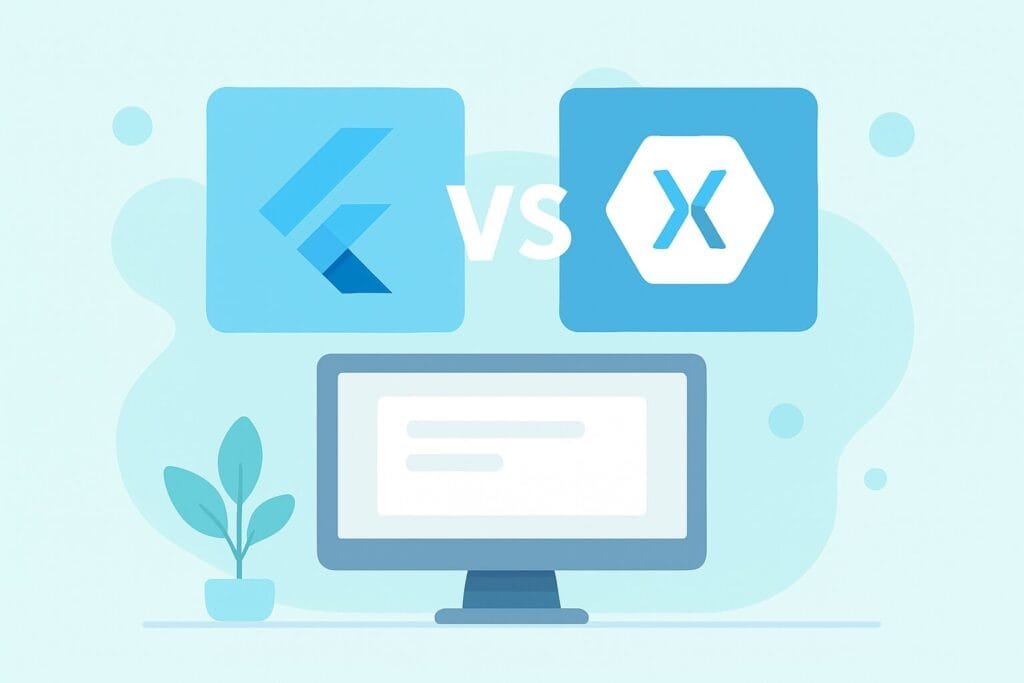In the rapidly evolving mobile development world, choosing the right cross-platform framework can make or break your project. Two of the most prominent contenders are Flutter and Xamarin. Both promise “write once, run anywhere” advantages, but their architectures, ecosystems, performance profiles, and trade-offs differ significantly. In this article, we’ll compare Flutter vs Xamarin in depth, walk through pros and cons, show a comparison table, and guide you toward the best fit for your next app.

What Is Flutter?
Flutter, developed and maintained by Google, is an open-source UI toolkit that enables developers to build natively compiled applications across mobile, web, and desktop from a single codebase. :contentReference[oaicite:0]{index=0}
Flutter uses the Dart programming language and includes its own rendering engine. Because UI and logic are both built with Dart and Flutter controls are rendered by the framework itself, you gain consistency across platforms. :contentReference[oaicite:1]{index=1}
One of Flutter’s most celebrated features is “hot reload,” which enables developers to quickly see UI changes during development without restarting the full app. :contentReference[oaicite:2]{index=2}
What Is Xamarin?
Xamarin is (or rather was, as Microsoft transitions to .NET MAUI) a cross-platform mobile development framework using the .NET ecosystem and C#. :contentReference[oaicite:3]{index=3}
Xamarin allows developers to share business logic across iOS, Android, and sometimes Windows, while letting you choose between Xamarin.Forms (for more shared UI) or Xamarin.Native (for maximum platform-specific control). :contentReference[oaicite:4]{index=4}
Note: Microsoft officially ended support for Xamarin in favor of .NET MAUI starting May 2024, so choosing Xamarin now may involve migration considerations. :contentReference[oaicite:5]{index=5}
Key Comparison: Flutter vs Xamarin
| Criterion | Flutter | Xamarin |
|---|---|---|
| Programming Language | Dart | C#, F# (via .NET) |
| Rendering / UI Approach | Own rendering engine, full control of pixels | Uses native UI mapping (via renderers) or shared UI in Xamarin.Forms |
| Performance | Near-native performance due to AOT compilation | Generally good, but may lag behind Flutter in heavy UI/animation scenarios |
| Hot Reload / Productivity | Fast hot reload, good iteration speed | Has hot reload / hot restart features (improved over time) :contentReference[oaicite:6]{index=6} |
| Code Reuse | High reuse of UI + logic across platforms | Strong reuse of business logic; UI reuse via Xamarin.Forms but some platform-specific UI required |
| Community & Ecosystem | Rapidly growing, many plugins/packages, strong Google support | Mature .NET / Microsoft backing, but declining popularity in recent years :contentReference[oaicite:7]{index=7} |
| App Size | Binary tends to be larger because it bundles engine | Also tends to produce larger app binaries, sometimes marginally smaller than Flutter in simple scenarios |
| Platform Support & Future | Supports mobile, web, desktop; rapid evolution | Support ended; migration to .NET MAUI is recommended :contentReference[oaicite:8]{index=8} |
| Learning Curve | Easy to pick up if new to Dart; framework is opinionated | Advantage if team is already familiar with C#/.NET |
Pros & Cons: Flutter vs Xamarin
Advantages of Flutter
- Consistent UI across platforms and fine-grained control of visuals via its rendering engine
- Excellent developer experience (hot reload, fast iteration)
- Strong and growing plugin ecosystem
- Cross-platform support including desktop and web
Limitations of Flutter
- Large app size overhead (engine, framework)
- Less mature in some niche native integrations
- Need for additional platform channels or bridging when accessing platform-specific features
Advantages of Xamarin
- Familiarity advantage for existing .NET / C# teams
- Shared business logic across platforms, with potential performance benefits in logic-heavy parts
Limitations of Xamarin
- Microsoft ended support; migration path to .NET MAUI is required :contentReference[oaicite:9]{index=9}
- UI abstraction (Xamarin.Forms) may lag behind in highly custom designs
- Sometimes slower adoption of new platform-specific features
When to Choose Flutter vs Xamarin / .NET MAUI
There’s no one-size-fits-all answer — your choice should depend on team skills, project requirements, and long-term maintenance considerations.
- Choose Flutter if:
- You want high-performance UIs, smooth animations, full control over visuals
- Your team is open to learning Dart or already has some Dart experience
- You expect to target mobile + web + desktop from the same base
- You want to take advantage of a thriving, active ecosystem
- Consider Xamarin / .NET MAUI if:
- Your team is already strong in C# / .NET
- You have significant legacy code in Xamarin or .NET you wish to reuse
- Your architecture demands deep integration with Microsoft / Azure ecosystem
Note on Migration: Xamarin → .NET MAUI
Since Microsoft has phased out Xamarin in favor of .NET MAUI (Multi-platform App UI), new greenfield projects are generally encouraged to start with MAUI instead of Xamarin. If you have an existing Xamarin project, migrating to MAUI may be a strategic move — many concepts are similar, but MAUI offers improved support and future viability. For more on .NET MAUI, see Microsoft’s official documentation. Learn more about .NET MAUI.
Conclusion: Which Is Best?
In a head-to-head between Flutter vs Xamarin, Flutter often wins in terms of performance, visual control, ecosystem momentum, and multi-platform reach. However, Xamarin (or rather the transition to .NET MAUI) still holds value in environments where .NET skills, legacy integration, or Microsoft ecosystem alignment matter more than bleeding-edge UI performance.
Ultimately, choose the framework that aligns best with your team’s expertise, project requirements, and long-term maintainability. If you’re starting new and want a future-proof, high-performance path, Flutter is a strong bet — but if you’re already deeply invested in .NET, the Xamarin → MAUI path may serve you better.

